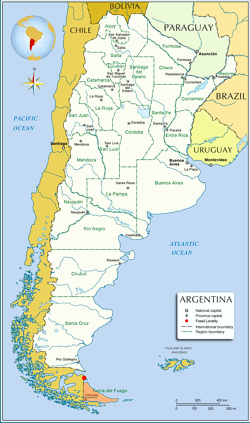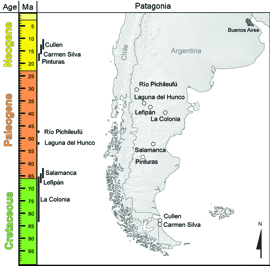The Cullen Formation outcrops at the coastal cliffs  in the northeast of the Isla Grande of Tierra del Fuego, southernmost of the Argentine Patagonia. They are continental deposits of early to mid Miocene in age, based on K-Ar isotopic analysis corroborated by palynological correlations.
in the northeast of the Isla Grande of Tierra del Fuego, southernmost of the Argentine Patagonia. They are continental deposits of early to mid Miocene in age, based on K-Ar isotopic analysis corroborated by palynological correlations.
The formation is characterized by abundant levels of leaf impressions and others with paleosols. The macroflora is not diverse and it is broadly dominated by leaves of several species of the South American Beech Nothofagus.
The microflora is abundant and diverse, and contains spores of algae, bryophytes and pteridophytes as well as pollen grains of gymnosperms and angiosperms. The best represented families are Zygnemataceae, Anthocerotaceae, Sphagnaceae, Ophioglossaceae, Adiantaceae, Podocarpaceae, Araucariaceae, Nothofagaceae, Apiaceae, Rosaceae, Chenopodiaceae, Sapindaceae, Proteaceae, Rubiaceae, Gunneraceae, and Sparganiaceae/Typhaceae, among others.
The palynological information coupled with the stratigraphic evidence indicate a paleoenvironment dominated by a multistratified forest dominated by Nothofagus and Podocarpaceae, a well-developed and diverse herbaceous subcanopy, and developments of local fresh-water communities characterized by semi-aquatic plants and coastal communities that grew under a humid and template climate very different from today’s.
Currently, this paleoflora is being re-examined in a broader framework that includes a set of Neogene paleofloras known as small isolated outcrops that could be interpreted as local manifestations of a broader vegetation unit that would have dominated all of southern Patagonia during the warm period of the Neogene.
Lab Work
Much of the detailed work involved in describing and understanding species of fossil plants takes place in the lab. We employ many traditional methods of paleobotanical study, such as making observations, describing fossil species, and comparing fossil species to living plants, in order to understand the plants that we find in the field. In addition, we use modern analytical techniques to attempt to gain a more precise understanding of the evolutionary relationships of fossil and living plants.
Other Paleofloras
(Youngest-Oldest)
- Cenozoic Paleofloras
- Cullen (middle Miocene)
- Carmen Silva (Miocene)
- Pinturas (late-early Miocene)
- Río Pichileufú (early-middle Eocene)
- Laguna del Hunco (Early Eocene)
- Salamanca (early Paleocene)
- Cretaceous Paleofloras
- Lefipán (Maastrichtian- 65.5-66 myo)
- La Colonia (Campanian to Maastrichtian)
